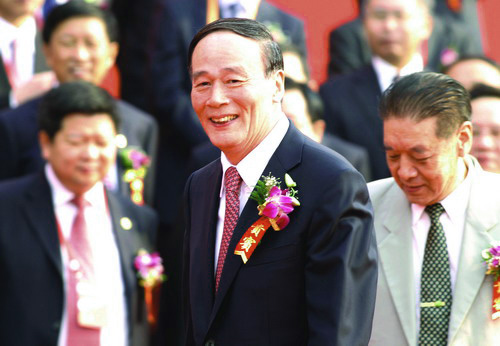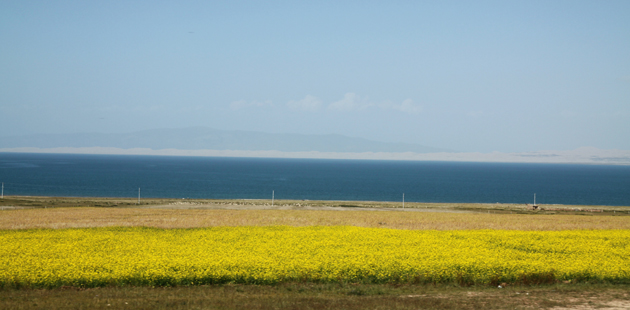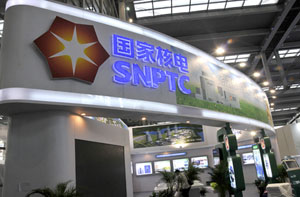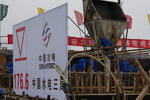Central region opening up
Updated: 2011-09-27 09:25
By Zhou Siyu (China Daily)
|
|||||||||||
|
 Vice-Premier Wang Qishan attends the opening ceremony of Expo Central China in Taiyuan, the capital of central China's Shanxi province. Wang said China will enhance competition-based regulation.[Photo/China Daily] |
TAIYUAN - China will further open up its central region to foreign investments, as a way to accelerate the country's industrial upgrading and maintain sustainable economic growth, senior central government officials said on Sept 26.
"We will continue creating a fairer and more transparent investment environment to attract more foreign investments to the central China region," Vice-Premier Wang Qishan said during a forum at Expo Central China 2011 in Taiyuan, the capital of Shanxi province.
With a total area of 1.03 million square kilometers and a population of 370 million, the central China region consists of six provinces: Shanxi, Anhui, Jiangxi, Henan, Hubei and Hunan.
The area boasts abundant land, mineral resources and low-cost labor. It accounts for one-fifth of the nation's economy, but it is also home to numerous traditional industries.
In recent years, China has reiterated its intention to develop the central region by encouraging industrial relocation from wealthy coastal provinces. In doing so, the government expects to optimize the national industrial structure and tap into consumer demand in the heartland.
"In developing the central China region, we should rely more on the market mechanism and enhance the protection of intellectual property," Wang added.
"The central provinces should also focus on developing education, so as to transform (the region's) abundant labor into human resources," he said.
In the meantime, as the world economy is struggling with a fragile recovery, further opening up the central region and attracting more investment will help boost the country's economic confidence, said International Trade Representative Gao Hucheng, who is also the vice-minister of commerce.
"The central China region boasts an excellent position. We should enhance the development of logistical systems to facilitate regional transportation and stimulate economic growth," he said.
He added that to encourage industrial relocation, the government is working on guidance for foreign investments for the region.
Propelled by the government's policies, the central region has outperformed other parts of the country in attracting foreign direct investment (FDI) in recent years.
In 2010, FDI to central China region surged by 28.6 percent year-on-year to $9.02 billion, while FDI in the eastern region increased 15.8 percent, according to data from the Ministry of Commerce.
During the January-August period of this year, FDI in central China region jumped 32 percent year-on-year to $5.57 billion, 14 percentage points higher than the country's average increase.
As the government continues to promote industrial relocation, the region will undergo further development, Hao Hongmei, a researcher at the Chinese Academy of International Trade and Economic Cooperation, said in a recent interview.
"Compared with eastern China, FDI in the central China region is likely to display a faster, more stable increase in the next few years," said Hao.
"The central China region offers huge business opportunities in the mining sector," said Kevin Thieneman, chairman of Caterpillar (China) Investment Co Ltd, a division of the maker of construction and mining equipment.
The company set up a joint venture with a Chinese company last month in Xi'an, the capital of western China's Shaanxi province.
"The central China region still has room to improve, especially in its logistics system and human resources," Thieneman said.
"We will learn from business experience through the joint venture in Shaanxi province and then decide on further investment in the central region," he said. "I am very optimistic about our future business here."
Related Stories
DHL expands service in West, Central China 2011-09-21 07:48
UPS to open new branch in Central China 2011-08-25 09:48
Central China city to build world's 3rd tallest building 2010-12-21 17:10
Foxconn paves way for production base in central China 2010-12-09 11:06
- China steps up regulation of rare earth industry
- Central region opening up
- Rising prices cut into incomes
- Subaru to recall 36,728 vehicles in China
- China's mobile phone users exceed 940m
- China issues growth plan for SMEs
- Sinohydro aims to raise $2.3b in Shanghai IPO
- Draft law for mandated warranties released













